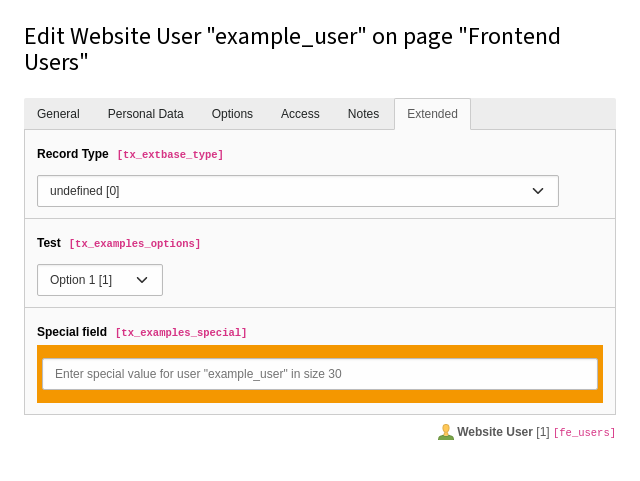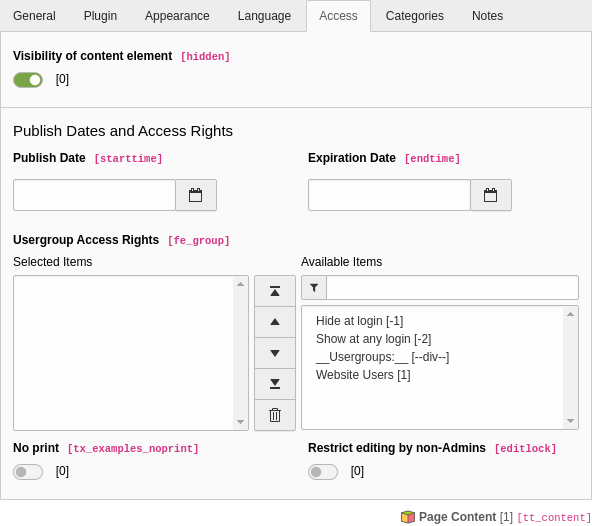Attention
TYPO3 v11 has reached end-of-life as of October 31th 2024 and is no longer being maintained. Use the version switcher on the top left of this page to select documentation for a supported version of TYPO3.
Need more time before upgrading? You can purchase Extended Long Term Support (ELTS) for TYPO3 v11 here: TYPO3 ELTS.
Customization Examples
Many extracts can be found throughout the manual, but this section provides more complete examples.
Example 1: Extending the fe_users table
The "examples" extension adds two fields to the "fe_users" table.
Here's the complete code, taken from file
Configuration/:
<?php
defined('TYPO3') or die();
// Add some fields to fe_users table to show TCA fields definitions
\TYPO3\CMS\Core\Utility\ExtensionManagementUtility::addTCAcolumns('fe_users',
[
'tx_examples_options' => [
'exclude' => 0,
'label' => 'LLL:EXT:examples/Resources/Private/Language/locallang_db.xlf:fe_users.tx_examples_options',
'config' => [
'type' => 'select',
'renderType' => 'selectSingle',
'items' => [
['',0,],
['LLL:EXT:examples/Resources/Private/Language/locallang_db.xlf:fe_users.tx_examples_options.I.0',1,],
['LLL:EXT:examples/Resources/Private/Language/locallang_db.xlf:fe_users.tx_examples_options.I.1',2,],
['LLL:EXT:examples/Resources/Private/Language/locallang_db.xlf:fe_users.tx_examples_options.I.2','--div--',],
['LLL:EXT:examples/Resources/Private/Language/locallang_db.xlf:fe_users.tx_examples_options.I.3',3,],
],
'size' => 1,
'maxitems' => 1,
],
],
'tx_examples_special' => [
'exclude' => 0,
'label' => 'LLL:EXT:examples/Resources/Private/Language/locallang_db.xlf:fe_users.tx_examples_special',
'config' => [
'type' => 'user',
// renderType needs to be registered in ext_localconf.php
'renderType' => 'specialField',
'parameters' => [
'size' => '30',
'color' => '#F49700',
],
],
],
]
);
\TYPO3\CMS\Core\Utility\ExtensionManagementUtility::addToAllTCAtypes(
'fe_users',
'tx_examples_options, tx_examples_special'
);Read why the check for the TYPO3 constant is necessary.
Note
The second example
tx_ only works when the
render has been registered implemented and then registered in
the ext_localconf.php. Please refer to the the following chapter of the
TCA reference on how to implement it: t3tca:.
In this example the first method call adds fields using
Extension. This ensures that the fields
are registered in
$GLOBALS. Parameters:
- Name of the table to which the fields should be added.
- An array of the fields to be added. Each field is represented in the TCA syntax for columns.
Since the fields are only registered but not used anywhere, the fields are
afterwards added to the "types" definition of the
fe_ table by
calling
Extension. Parameters:
- Name of the table to which the fields should be added.
- Comma-separated string of fields, the same syntax used in the showitem property of types in TCA.
- Optional: record types of the table where the fields should be added, see types in TCA for details.
- Optional: position (
'before'or'after') in relation to an existing field.
So you could do this:
\TYPO3\CMS\Core\Utility\ExtensionManagementUtility::addToAllTCAtypes(
'fe_users',
'tx_examples_options, tx_examples_special',
'',
'after:password'
);If the fourth parameter (position) is omitted or the specified field is not found, new fields are added at the bottom of the form. If the table uses tabs, new fields are added at the bottom of the Extended tab. This tab is created automatically if it does not exist.
These method calls do not create the corresponding fields in the database. The new
fields must also be defined in the ext_ file of the extension:
CREATE TABLE fe_users (
tx_examples_options int(11) DEFAULT '0' NOT NULL,
tx_examples_special varchar(255) DEFAULT '' NOT NULL
);Note
The above example uses the SQL
CREATE TABLE statement. This is the
way TYPO3 expects it to be. The Extension Manager will automatically
transform this into an
ALTER TABLE statement when it detects that the
table already exists.
The following screen shot shows the placement of the two new fields when editing a "fe_users" record:

The new fields added at the bottom of the "Extended" tab
The next example shows how to place a field more precisely.
Example 2: Extending the tt_content Table
In the second example, we will add a "No print" field to all content
element types. First of all, we add its SQL definition in
ext_:
CREATE TABLE tt_content (
tx_examples_noprint tinyint(4) DEFAULT '0' NOT NULL
);Then we add it to the
$GLOBALS in Configuration/:
\TYPO3\CMS\Core\Utility\ExtensionManagementUtility::addTCAcolumns(
'tt_content',
[
'tx_examples_noprint' => [
'exclude' => 0,
'label' => 'LLL:EXT:examples/Resources/Private/Language/locallang_db.xlf:tt_content.tx_examples_noprint',
'config' => [
'type' => 'check',
'renderType' => 'checkboxToggle',
'items' => [
[
0 => '',
1 => ''
]
],
],
],
]
);
\TYPO3\CMS\Core\Utility\ExtensionManagementUtility::addFieldsToPalette(
'tt_content',
'access',
'tx_examples_noprint',
'before:editlock'
);The code is mostly the same as in the first example, but the last method call
is different and requires an explanation. The tables pages and
tt_ use palettes extensively. This increases
flexibility.
Therefore we call Extension
instead of Extension.
We need to specify the palette's key as the second argument (access).
Precise placement of the new field is achieved with the fourth parameter
(before:). This will place the "no print" field right before the
Restrict editing by non-Admins field, instead of putting it in the
Extended tab.
The result is the following:

The new field added next to an existing one
Note
Obviously this new field will not magically exclude a content element
from being printed. For it to have any effect, it must be used during
the rendering by modifying the TypoScript used to render the
tt_ table. Although this is outside the scope of this
manual, here is an example of what you could do, for the sake of
showing a complete process.
Assuming you are using "fluid_styled_content" (which is installed by default), you could add the following TypoScript to your template:
tt_content.stdWrap.outerWrap = <div class="noprint">|</div>
tt_content.stdWrap.outerWrap.if.isTrue.field = tx_examples_noprintThis will wrap a "div" tag with a "noprint" class around any content element that has its "No print" checkbox checked. The final step would be to declare the appropriate selector in the print-media CSS file so that "noprint" elements don't get displayed.
This is just an example of how the effect of the "No print" checkbox
can be ultimately implemented. It is meant to show that just adding
the field to the
$GLOBALS is not enough.
